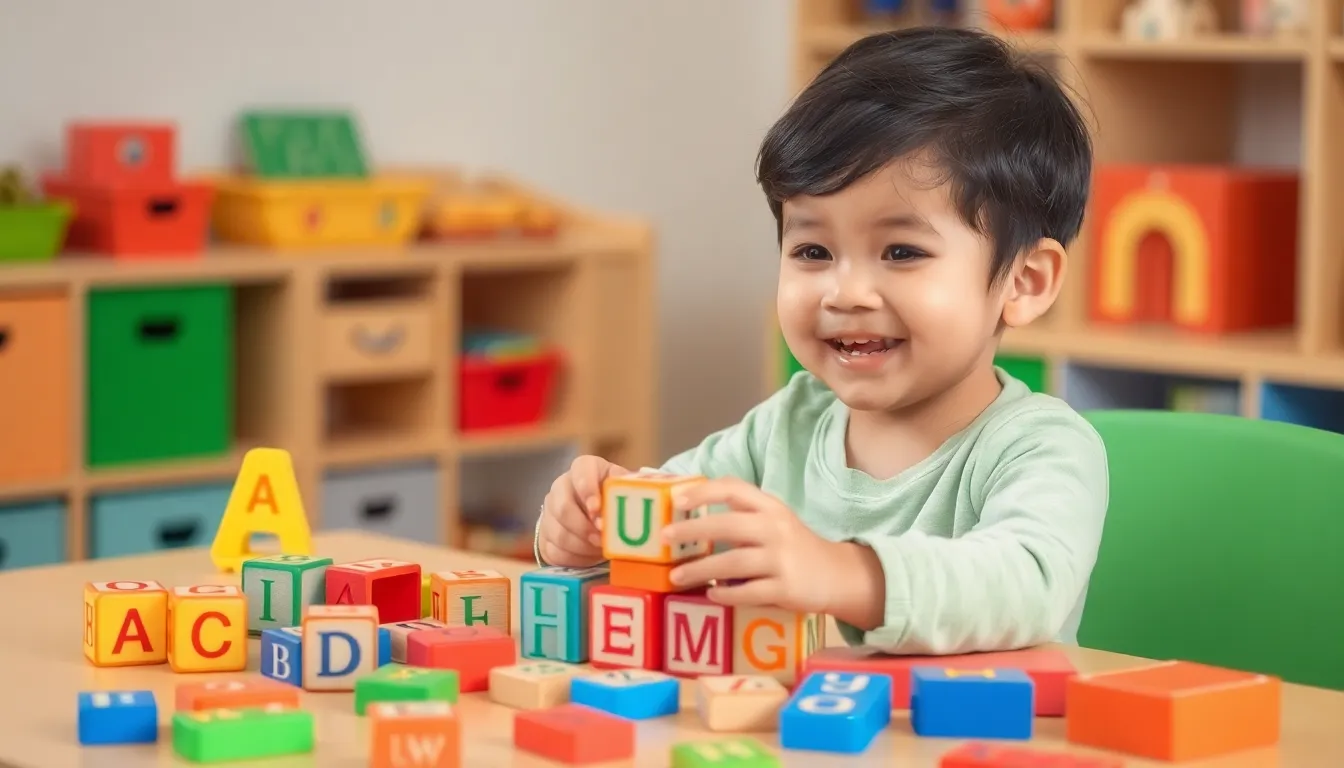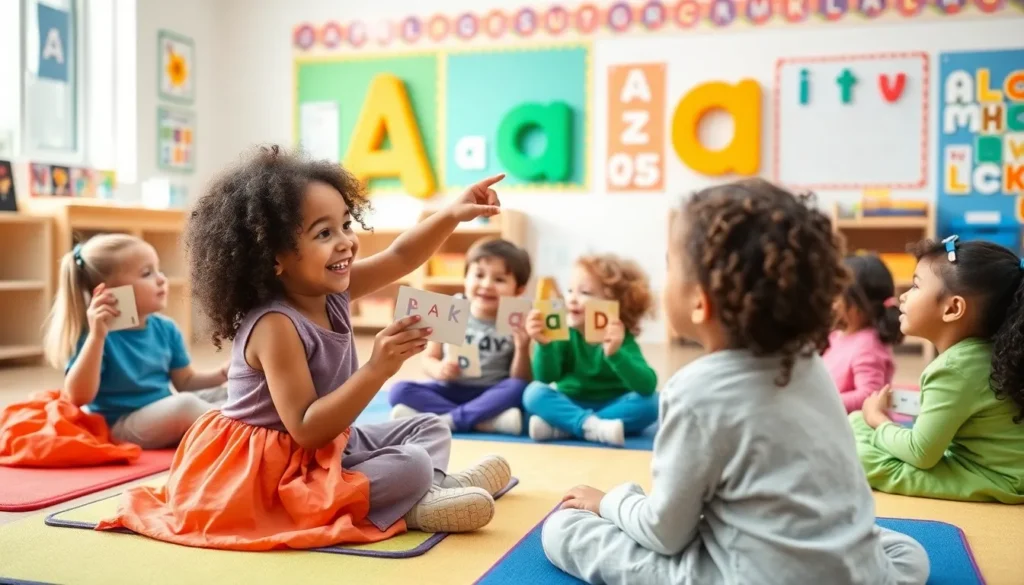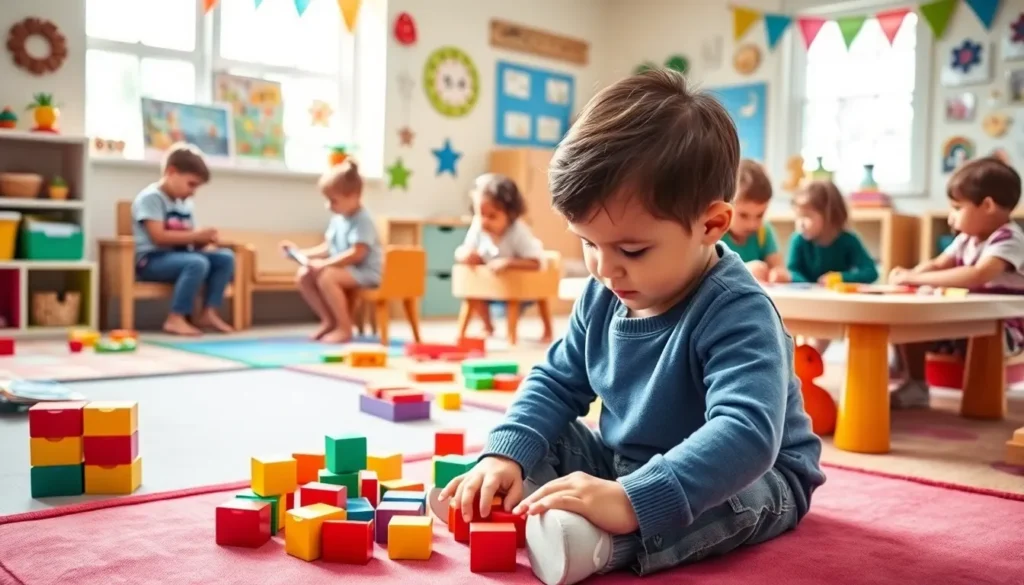Imagine a world where letters dance off the page, waving their arms, and shouting, “Pick me! Pick me!” While that might sound like a whimsical dream, letter recognition is the key to unlocking the magic of reading and writing. It’s the superhero skill that transforms a jumble of shapes into words that tell stories, share ideas, and even make grocery lists.
Table of Contents
ToggleOverview of Letter Recognition
Letter recognition involves identifying and naming letters in both uppercase and lowercase forms. This skill serves as the foundation for the development of literacy. It enables individuals to understand the building blocks of written language. Children typically start learning letters around age three or four.
Recognizing letters is crucial in early childhood education. Educational systems often include activities designed to enhance letter recognition. Flashcards, letter games, and interactive apps facilitate the learning process. Research indicates that consistent exposure to letters increases children’s literacy skills significantly.
Visual and auditory recognition plays a role in how individuals learn letters. Some learners benefit from associating sounds with specific letters. Phonics programs provide structured approaches to linking sounds and letters. Multi-sensory learning experiences also support various learning styles.
Additionally, letter recognition impacts vocabulary development. Children who recognize letters early tend to develop a richer vocabulary. These individuals often transition more smoothly into reading comprehension skills. This correlation underscores the importance of a solid foundation in letter recognition.
In pre-school and kindergarten classrooms, teachers emphasize letter recognition through engaging methods. Classroom environments often feature printed letters and signs. This visual accessibility encourages repetition and reinforcement, contributing to familiarity.
Assessments can monitor progress in letter recognition. Standardized tests and teacher-created assessments help identify areas for improvement. Such evaluations support targeted instruction, ensuring that every learner has the opportunity to develop their skills.
Recognizing letters not only supports academic success but also fosters confidence in communication. This essential skill sets the stage for future reading and writing endeavors, shaping informed and expressive individuals.
Importance of Letter Recognition

Letter recognition significantly impacts a child’s development in various ways, establishing a strong foundation for future academic achievements. Understanding letters and how they form words plays a vital role in early education.
Cognitive Development
Cognitive development thrives with early letter recognition. Recognizing letters helps children develop memory and processing skills. Engaging with letters enhances their ability to categorize information and build connections between symbols and sounds. Incorporating letter games stimulates critical thinking and problem-solving abilities. Studies indicate a strong correlation between early letter recognition and improved intellectual skills as children progress in their education. As cognitive skills grow, children become more confident in their learning journey.
Early Literacy Skills
Early literacy skills are built through letter recognition. Identifying letters lays the groundwork for phonemic awareness, crucial for reading. Recognizing letters enables children to decode words, paving the way for reading fluency. Exposure to letters in various contexts allows children to grasp the relationship between spoken and written language. Interactive activities, such as reading together and playing letter-focused games, foster these essential skills. Research shows children proficient in letter recognition demonstrate more significant reading comprehension as they advance through grades. This skill not only enhances literacy but also prepares them for future communication.
Methods of Teaching Letter Recognition
Effective teaching methods enhance letter recognition skills in young learners. Two prominent approaches include the phonics approach and the whole language approach.
Phonics Approach
The phonics approach emphasizes the relationship between sounds and letters. It involves teaching children how to decode words through letter-sound correspondence. Activities may include sound-letter matching games and guided reading sessions focused on phonemic awareness. Research shows that explicit instruction in phonics boosts early reading skills, leading to better decoding and comprehension. Teachers often use songs and rhymes to reinforce sounds, making learning enjoyable. This method aligns with various learning styles and provides a structured way for children to grasp the fundamentals of reading.
Whole Language Approach
The whole language approach focuses on meaning and context in learning letters. This method encourages children to recognize letters within words and sentences rather than in isolation. Immersive reading experiences, such as storytime and shared reading, promote letter recognition alongside vocabulary development. Classrooms often feature print-rich environments with signs and labels to support recognition in a real-world context. By integrating letters into meaningful texts, children develop a holistic understanding of language. This approach fosters a love for reading and writing, as learners connect with stories and ideas visually and phonetically.
Challenges in Letter Recognition
Letter recognition presents several challenges that can hinder a child’s literacy development. Understanding these difficulties allows educators and caregivers to create effective interventions.
Common Learning Difficulties
Some children struggle with letter recognition due to various factors. Visual processing issues may prevent them from distinguishing similar letters, such as ‘b’ and ‘d.’ Auditory processing deficits can affect their ability to connect sounds with corresponding letters. Additionally, children with language delays might find it hard to grasp letter names and sounds. Motivation also plays a crucial role; disinterest can lead to insufficient practice. Recognition of these challenges helps stakeholders tailor instruction that meets individual needs.
Tools and Resources
A variety of tools and resources exist to support letter recognition development. Flashcards serve as effective visual aids, facilitating quick recall of letters. Interactive apps offer engaging activities that reinforce skills through repetition and play. Worksheets emphasize hands-on learning, allowing children to trace letters and practice writing. Educators often incorporate games that promote letter recognition in group settings, encouraging collaboration among peers. Online resources provide lesson plans and activities that cater to different learning styles, further enriching the educational experience.
Future Trends in Letter Recognition Research
Emerging technologies play a significant role in advancing letter recognition research. Researchers explore artificial intelligence to improve learning outcomes. Innovations like machine learning models enable personalized learning experiences, adapting to individual student needs. Interface design of educational apps enhances user engagement while promoting letter recognition skills.
Increased focus on neuroimaging techniques provides insights into how children process letters. Advanced methods, such as functional magnetic resonance imaging (fMRI), reveal brain activity patterns during letter recognition tasks. Analyzing these patterns aids educators in understanding effective teaching strategies aligned with cognitive development.
Multisensory learning approaches continue gaining traction. Integrating visual, auditory, and kinesthetic activities fosters a deeper understanding of letter shapes and sounds. Research shows that these combined techniques increase retention rates and improve overall literacy skills among young learners.
Collaboration between researchers and educators is becoming more common. Partnerships aim to translate research findings into practical classroom applications. This synergy helps ensure that evidence-based strategies are widely adopted in early childhood education.
Another trend focuses on inclusive practices that address diverse learning needs. Developing interventions tailored to children with learning disabilities encourages effective letter recognition. Such strategies significantly improve literacy outcomes for all learners.
Ongoing evaluations of existing programs are crucial. Collecting data on the effectiveness of various teaching methodologies informs continuous improvement in educational practices. Ultimately, these trends indicate a promising future for letter recognition research, paving the way for enhanced literacy development across diverse populations.
Letter recognition is a vital stepping stone in a child’s literacy journey. By fostering this skill early on, parents and educators set the stage for successful reading and writing experiences. Engaging activities and tailored instruction play a crucial role in helping children overcome challenges and develop confidence in their abilities.
As research and technology continue to evolve, the future of letter recognition looks promising. Embracing innovative teaching methods and inclusive practices ensures that every child can thrive. Ultimately, nurturing letter recognition not only enhances academic performance but also enriches a child’s overall development, paving the way for lifelong communication skills.




